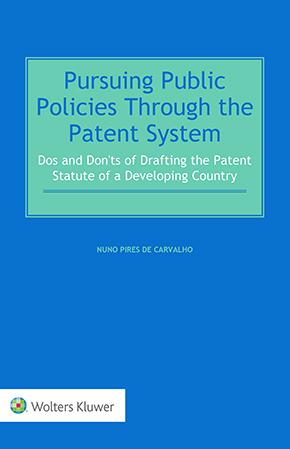 Pursuing Public Policies Through the Patent System is a deeply informative study, which analyzes more than fifty national statutes of developing countries and more than ten international agreements. One of the world’s most renowned intellectual property law scholars thoroughly describes the domestic objectives a developing country’s patent statute should pursue while still complying with international treaties. There is a general consensus among intellectual property law experts – and among global organizations, such as the World Trade Organization and the World Intellectual Property Organization – that patent statutes for developing countries should recognize such countries’ distinctive public policies. Pursuing Public Policies Through the Patent System is a deeply informative study, which analyzes more than fifty national statutes of developing countries and more than ten international agreements. One of the world’s most renowned intellectual property law scholars thoroughly describes the domestic objectives a developing country’s patent statute should pursue while still complying with international treaties. There is a general consensus among intellectual property law experts – and among global organizations, such as the World Trade Organization and the World Intellectual Property Organization – that patent statutes for developing countries should recognize such countries’ distinctive public policies.
The framework developed by Pires de Carvalho depicts how, because inventors are granted effective security under the TRIPS Agreement to seek opportunities to commercially exploit their inventions in any country, the patent lawmaker of a developing country is under pressure to ensure that the law should reduce the burden of sharing the costs of invention to the minimum possible, and should provide for a mechanism of granting patents that is efficient but simple and cost-effective and does not impose a heavy burden on the country’s public administration yet still provide legal security to inventors.
What’s in this book:
In developing his framework, the author intensively explores the following crucial approaches:
- thorough analysis of how sensitive matters can be addressed, such as exclusions from patentability, patent amendments, compulsory licenses, and extension of patent terms;
- suggestions on language addressing topics of particular interest to developing countries, such as enabling disclosure, the requirement to disclose the origin of genetic resources, informed consent on the use of traditional knowledge, and the protection of handicrafts;
- implementing measures that, without infringing international obligations, seek creative solutions that respect the national interests in terms of reducing the exclusionary impact of patents owned by non-residents;
- substantive versus merely formal examination prior to the grant of the patent;
- recognition of inventions made by employees or civil servants; and
- understanding the impact of pre-grant and post-grant challenges, third-party observations, invalidation, and revocation.
Each chapter includes a useful dos and don’ts section indicating best practices, attending to the chapter’s particular focus.
How this will help you:
The nonpareil summary and analysis contained in this book will assist lawmakers of developing countries in pursuing the public policies of their choice through national patent statutes, explain the adequate meaning and scope of a large number of patent-related statutory provisions found in the laws of developing countries, and guide IP practitioners and academics on the interpretation and construction of the most controversial provisions in patent statutes.
Table Of Contents
Preamble
Introduction
Chapter 1
On the Right to Apply for (and Obtain) the Patent
Chapter 2
On the Examination of Patent Applications
Chapter 3
On Patentability
Chapter 4
On Formal and Substantive Requirements of Patentability
Chapter 5
Amending the Application
Chapter 6
Pre-grant and Post-grant Challenges, Third-Party Observations, Invalidation, Revocation
Chapter 7
On the Rights Conferred by the Patent: Setting and Calibration
Chapter 8
On the Independence of Patents and of the Rights They Confer
Chapter 9
On the Terms of Patents and Their Extension
Chapter 10
On the Use of Patent Rights: Licensing and Enforcement
Chapter 11
Other Issues
Index |
 Pursuing Public Policies Through the Patent System is a deeply informative study, which analyzes more than fifty national statutes of developing countries and more than ten international agreements. One of the world’s most renowned intellectual property law scholars thoroughly describes the domestic objectives a developing country’s patent statute should pursue while still complying with international treaties. There is a general consensus among intellectual property law experts – and among global organizations, such as the World Trade Organization and the World Intellectual Property Organization – that patent statutes for developing countries should recognize such countries’ distinctive public policies.
Pursuing Public Policies Through the Patent System is a deeply informative study, which analyzes more than fifty national statutes of developing countries and more than ten international agreements. One of the world’s most renowned intellectual property law scholars thoroughly describes the domestic objectives a developing country’s patent statute should pursue while still complying with international treaties. There is a general consensus among intellectual property law experts – and among global organizations, such as the World Trade Organization and the World Intellectual Property Organization – that patent statutes for developing countries should recognize such countries’ distinctive public policies.